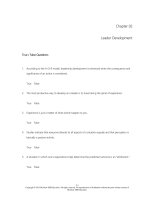Lecture Leadership: Enhancing the lessons of experience (4/e) – Chapter 10
Bạn đang xem bản rút gọn của tài liệu. Xem và tải ngay bản đầy đủ của tài liệu tại đây (535.34 KB, 14 trang )
101
McGrawHill/Irwin
© 2002 The McGrawHill Companies, Inc., All Rights Reserved.
C
HAPTER
T
EN
Groups,Teams, and
Their Leadership
Differences Between
Organizations and Groups
• An organization can be so large that most
members do not know most of the other
people within it.
• Groups are small and immediate enough to
impact both feelings and self image.
• People tend to be more psychologically
invested with groups to which they belong.
• Certain psychological needs are better
satisfied by groups.
McGrawHill/Irwin
© 2002 The McGrawHill Companies, Inc., All Rights Reserved.
103
Six Basic Concepts For
Understanding Group Perspective
•
•
•
•
•
•
Group size
Stages of group development
Roles
Norms
Communication
Cohesion
McGrawHill/Irwin
© 2002 The McGrawHill Companies, Inc., All Rights Reserved.
104
Implications Of Group Size
• Leader emergence is partially a
function of group size.
• As groups become larger, cliques are
more likely to form, and many
intergroup conflicts are the result of
cliques.
• Group size can affect a leader’s
behavioral style.
• Group size affects group
effectiveness.
McGrawHill/Irwin
© 2002 The McGrawHill Companies, Inc., All Rights Reserved.
105
Developmental Stages Of Groups
Forming
McGrawHill/Irwin
Storming
Norming
Performing
© 2002 The McGrawHill Companies, Inc., All Rights Reserved.
106
Task Roles In Groups
• Initiating: defining the problem, suggesting
activities, assigning tasks.
• Information seeking: asking questions, seeking
relevant data or views.
• Information sharing: providing data, offering
opinions.
McGrawHill/Irwin
© 2002 The McGrawHill Companies, Inc., All Rights Reserved.
107
Task Roles In Groups, continued
108
• Summarizing: reviewing and integrating others’
points, checking for common understanding and
readiness for action.
• Evaluating: assessing validity of assumptions,
quality of information, reasonableness of
recommendations.
• Guiding: keeping group on track.
McGrawHill/Irwin
© 2002 The McGrawHill Companies, Inc., All Rights Reserved.
Relationship Roles In Groups
• Harmonizing: resolving interpersonal
conflicts, reducing tension.
• Encouraging: supporting and praising
others, showing appreciation for other's
contributions, being warm and friendly.
• Gatekeeping: assuring even participation
by all group members, making sure that
everyone has a chance to be heard and
that no individual dominates.
McGrawHill/Irwin
© 2002 The McGrawHill Companies, Inc., All Rights Reserved.
109
Why Group Cohesion Does Not
Always Lead To Higher Performance
• A highly cohesive but unskilled team is
still an unskilled team.
• A cohesive group may develop goals
that are contrary to the larger
organization’s goals.
• Overbounding: groups can
become so cohesive that they
erect fences and boundaries
between themselves and others.
McGrawHill/Irwin
© 2002 The McGrawHill Companies, Inc., All Rights Reserved.
1010
Why Group Cohesion Does Not Always Lead To 1011
Higher Performance, continued
• Group think: highly cohesive groups often
become more concerned with unanimity
than in objective appraisals.
• Ollieism: overzealous group members
may perform illegal actions because they
believe it will please their leaders.
McGrawHill/Irwin
© 2002 The McGrawHill Companies, Inc., All Rights Reserved.
Differences Between Groups and
Teams
• Team members usually have a
stronger sense of identification among
themselves than group members do.
• Teams have common goals or tasks.
• Task interdependence typically is
greater with teams than with groups.
McGrawHill/Irwin
© 2002 The McGrawHill Companies, Inc., All Rights Reserved.
1012
Organizational Shells
Environment
Environment
Industry
TAS
K
Organization
Group
formation
N
M
R
O
S
Team
at work
AU
OB
U
N
D
YRA
McGrawHill/Irwin
TH
OR
IT Y
© 2002 The McGrawHill Companies, Inc., All Rights Reserved.
1013
Ginnett’s Team Effectiveness 1014
Leadership Model
Team Leadership
Design
Industry
Organizational Inputs
maer D
Team Design
T1 Task
T2 Composition
T3 Norms
T4 Authority
I1 Interests/Motivation
I2 Skills/Abilities
I3 Values/Attitudes
P1 Effort
P2 Knowledge & Skills
P3 Strategy
P4 Group Dynamics
Feedback
Individual Inputs
Process Criteria
Feedback Feedback
04 Control System
Feedback on team effectiveness
Feedback
01 Reward Systems
02 Education Systems
03 Information Systems
Development
Environment
Team Effectiveness
Outcome acceptable to
stakeholders
Future capability of team
Individual satisfaction
Material Resources
Selfefficacy Feedback
I4 Interpersonal Behavior
McGrawHill/Irwin
© 2002 The McGrawHill Companies, Inc., All Rights Reserved.









